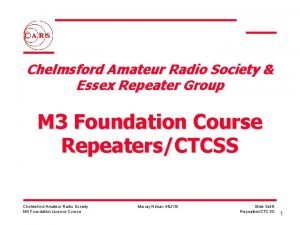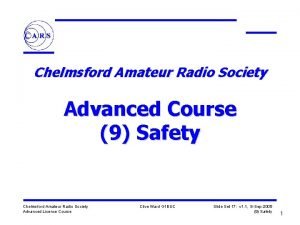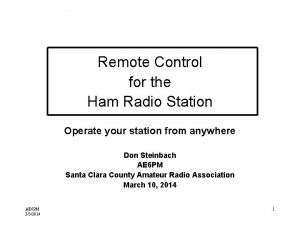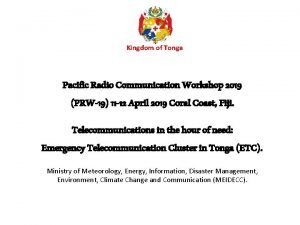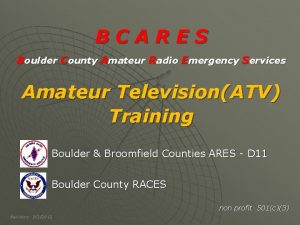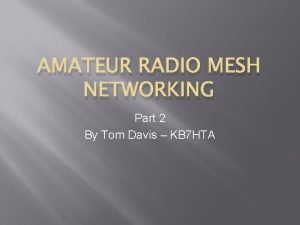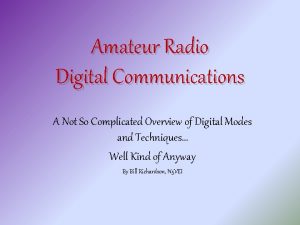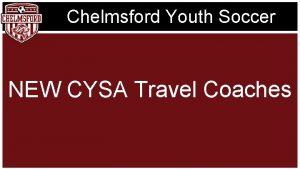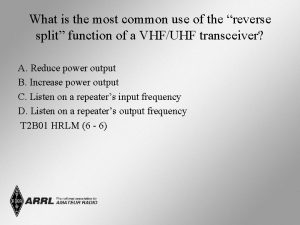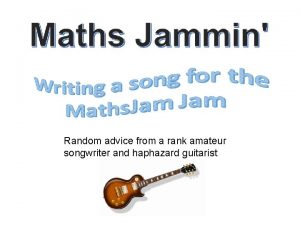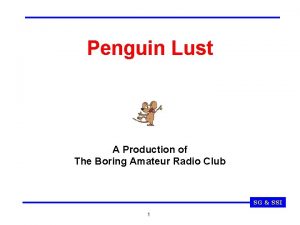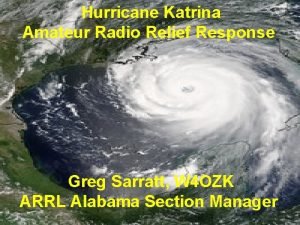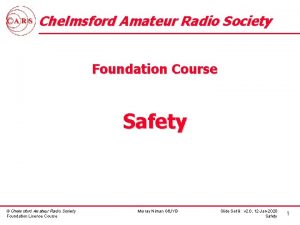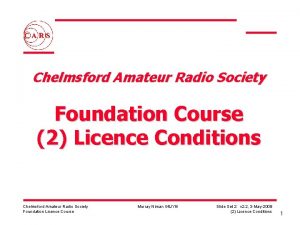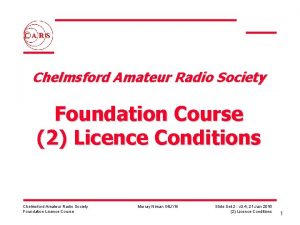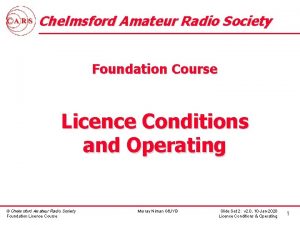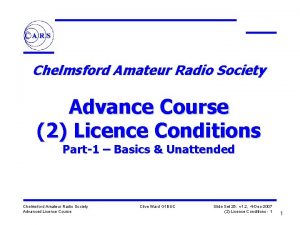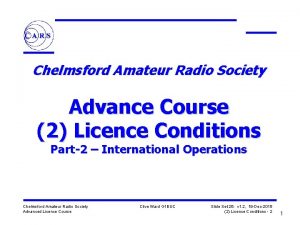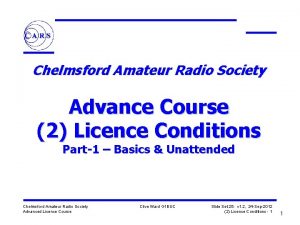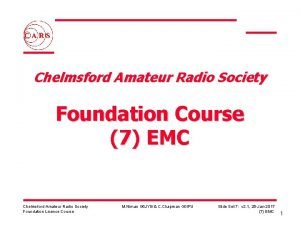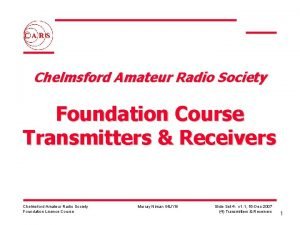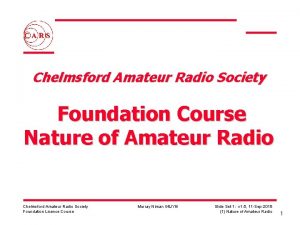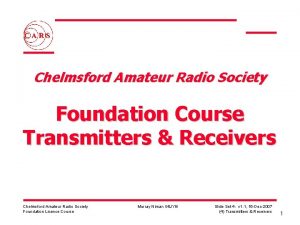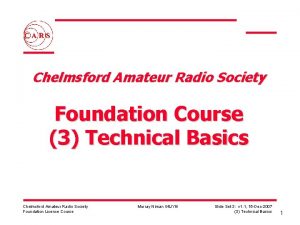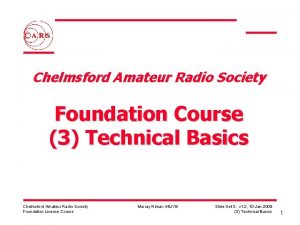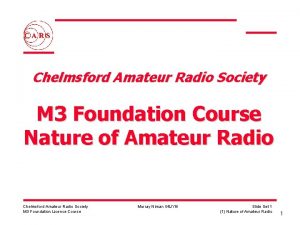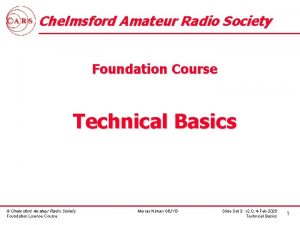Chelmsford Amateur Radio Society Foundation Course 2 Licence
















- Slides: 16

Chelmsford Amateur Radio Society Foundation Course (2) Licence Conditions Chelmsford Amateur Radio Society Foundation Licence Course Murray Niman G 6 JYB Slide Set 2: v 3. 6, 16 -Feb-2019 (2) Licence Conditions 1

Foundation Privileges • Foundation Licence is the entry level but still permits considerable potential for communications and learning • Allowed up to 10 Watts on most bands, - but note the exceptions in the Schedule! • Access to HF, VHF & UHF Bands, plus 10 GHz • Assumes certified transmitters or commercial kits • NB: Foundation Licence does NOT allow operation outside the UK, Airborne or Maritime Mobile (Vessels at Sea) • Should you progress… there is also: – Intermediate Licence: With more bands and construction, up to 50 Watts – Full Licence: All bands and international/maritime use, up to 400 Watts Chelmsford Amateur Radio Society Foundation Licence Course Murray Niman G 6 JYB Slide Set 2: v 3. 6, 16 -Feb-2019 (2) Licence Conditions 2

UK Licence Structure Class Callsign Bands • Foundation M#7 ABC HF-70 cms & 10 GHz • Intermediate 2#0 ABC • Full M#0 ABC Almost All Max Power* 10 Watts 50 Watts 400 Watts *Note – there are lower power exceptions/restrictions – see later / licence schedule • Where # is: I=N. Ireland D=I. of Man J=Jersey • Older Callsigns: Foundation=M 3, M 6 Class A=M 0/5, G 0/2/3/4/5 E=England (Intermediates only) M=Scotland U=Guernsey W=Wales Class B= M 1, G 1/6/7/8, 2 E 1 • Examples: M 7 QQQ, G 0 QQQ, 2 E 1 QQQ, 2 D 0 QQQ, MI 3 QQQ, GM 6 QQQ • Summary – Any callsign that starts with a M, G or 2 is a UK callsign Chelmsford Amateur Radio Society Foundation Licence Course Murray Niman G 6 JYB Slide Set 2: v 3. 6, 16 -Feb-2019 (2) Licence Conditions 3

Licence Conditions • Nowadays the conditions for all three levels of amateur licence were merged into a single document - READ IT CAREFULLY !! • Current version can be found on the Ofcom website: www. ofcom. org. uk • Take care not to download old versions from the Ofcom/RA archives! • It is important to identify those Clauses that only apply to Foundation - others may only apply to Intermediate or Full licensees • You must hold a current valid named version from the Ofcom online system for the station to be used. If it is not valid you cannot operate • Licence must be revalidated every 5 yrs - Try to do it more frequently! • Ensure you are able to log-on and access your own online version! Chelmsford Amateur Radio Society Foundation Licence Course Murray Niman G 6 JYB Slide Set 2: v 3. 6, 16 -Feb-2019 (2) Licence Conditions 4

General Rules • Ofcom is the statutory regulator for communications in the UK • Rights, rules, inspection and Close Down etc are all ultimately on the authority of Ofcom • Contacts must only be with other licensed amateurs • No public broadcasting, speeches, offensive language etc • Ofcom can also ‘vary’ your licence to modify or restrict use – perhaps in an interference situation • Ultimately, it can also revoke a licence entirely Chelmsford Amateur Radio Society Foundation Licence Course Murray Niman G 6 JYB Slide Set 2: v 3. 6, 16 -Feb-2019 (2) Licence Conditions 5

Rules-2 • Licensees may use codes and abbreviations to assist communication, but they must not obscure the meaning - so Q-codes, and established Morse code/abbreviations are fine • Any change of name/address must be notified immediately as Ofcom has the power to revoke – As it does for other breaches of Licence conditions • Amateur Satellite Operation is permitted, but needs care due split frequencies, doppler shift, excessive input powers • Airborne and Maritime Mobile Operation is not permitted – Inland waters, river/canal boats are okay! Chelmsford Amateur Radio Society Foundation Licence Course Murray Niman G 6 JYB Slide Set 2: v 3. 6, 16 -Feb-2019 (2) Licence Conditions 6

Abuse & Guidance Abuse • The transmission of music and the use of offensive or threatening language whilst on the air are unacceptable in amateur radio. • Do not respond on air, approach or confront individuals • If frequent - Log it • Ofcom have extensive advice online • Contact RSGB-OAS or use the Ofcom ‘Report Interference or Abuse’ online form Good Practice • A widely recommended guide to good practice is: “Ethics & Operating Procedures for the Radio Amateur” online at http: //www. hamradio-operating-ethics. org/ • Further information is on the Operating section of the RSGB website Chelmsford Amateur Radio Society Foundation Licence Course Murray Niman G 6 JYB Slide Set 2: v 3. 6, 16 -Feb-2019 (2) Licence Conditions 7

Callsigns & Suffixes • Must Give your Callsign: – As frequently as practicable during transmissions – To ensure you are clearly identifiable at all times – In an appropriate format consistent with the mode of operation – Typically at least once every 15 mins • When calling for the first time or changing frequency – your callsign is therefore needed to identify yourself! • Repeaters, Nets etc – Good practice to give Callsign more often than 15 mins! • It is also good practice to append the following…. . – Mobile Operation: Callsign /M – Temporary Location: Callsign /P – Alternative Addresses: Callsign /A Chelmsford Amateur Radio Society Foundation Licence Course Murray Niman G 6 JYB Slide Set 2: v 3. 6, 16 -Feb-2019 (2) Licence Conditions 8

Addresses / Locations • Definitions of Addresses should be understood as per Licence • Main Station Address is as per Page-1 of your own licence document • Mobile /M means located in the UK in/on any vehicle, pedestrian, or vessel in inland waters. For example: - M 6 QQQ/M • Alternative Address /A means a fixed Postal Address in the UK other than the Main Station Address. For example: - M 6 QQQ/A • Temporary Address /P means a fixed location other than your validation document or Alternative address. For example: - M 6 QQQ/P eg. A Contest Station in a field, which has no postal address • When operating from other locations, it is recommended to give your location within 5 km eg by IARU Locator, NGR, Lat/Long, Postcode, etc Chelmsford Amateur Radio Society Foundation Licence Course Murray Niman G 6 JYB Slide Set 2: v 3. 6, 16 -Feb-2019 (2) Licence Conditions 9

Supervision & User Services • Foundation Licensees may personally operate their Radio Equipment, or directly supervise another UK Amateur using it - provided they use your callsign and licence conditions. eg 10 W max etc • In special cases you may either pass messages on behalf of, or permit your equipment to be used by, the User Services – Police, Fire, Ambulance etc • In such exceptional circumstances the use of encryption or codes may be requested and used (eg for confidential patient/casualty details) Chelmsford Amateur Radio Society Foundation Licence Course Murray Niman G 6 JYB Slide Set 2: v 3. 6, 16 -Feb-2019 (2) Licence Conditions 10

Logbooks • Unlike yesteryear a permanent Log need not be kept but. . . • A person authorised by Ofcom may require a Licensee to keep a log of all transmissions made over a specified period of time: – To aid Interference Investigations – To determine Licence Condition Compliance by the Licensee • Well kept up-to-date logbooks are more likely to be accepted • Logbooks are also good practice and aid QSL Cards, Contests, Award Claims etc. • Also ideal for records of station tests - from time to time • Logbooks may be on paper or electronic media (backed up!) Chelmsford Amateur Radio Society Foundation Licence Course Murray Niman G 6 JYB Slide Set 2: v 3. 6, 16 -Feb-2019 (2) Licence Conditions 11

Frequency Schedule • Foundation Licence Frequency Schedules should be studied carefully - don’t confuse with Intermediate and Full ones • Allowed 10 Watts on most bands – BUT NOT ALL • Note those bands where restrictions exist: – Power or ERP limits, 100 km around Charing Cross – Examples are in 136 k. Hz, 430 -432 MHz, 10 GHz • Allocations may be Primary or Secondary – Secondary means the band is shared and you must not cause harmful interference to the Primary Users • You can be examined on the Foundation Frequency Schedule. . . – a copy is provided in the Exam - Use It !!! Chelmsford Amateur Radio Society Foundation Licence Course Murray Niman G 6 JYB Slide Set 2: v 3. 6, 16 -Feb-2019 (2) Licence Conditions 12

Frequency Schedule • Columns give frequencies and power limits for terrestrial and satellite use • Note those exceptions! • Remember to use it in the exam! Chelmsford Amateur Radio Society Foundation Licence Course Murray Niman G 6 JYB Slide Set 2: v 3. 6, 16 -Feb-2019 (2) Licence Conditions 13

Band Plans • Frequency Allocations and Maximum Powers are laid down in the Foundation Licence frequency schedule • Band Plans are agreed operating practice to group modes etc - contrast with Licence Schedules which have full legal force • Note transmission bandwidth varies with mode and is now specified in latest band plans - Don’t over deviate ! • Study band plans carefully and understand them • Note use of calling channels and availability of repeaters on VHF/UHF FM sections of the bands • Don’t have QSOs on Beacon Segments! • The 14 MHz and 144 MHz Band Plans may be used in the exam Chelmsford Amateur Radio Society Foundation Licence Course Murray Niman G 6 JYB Slide Set 2: v 3. 6, 16 -Feb-2019 (2) Licence Conditions 14

Band Plan Example • Columns give frequencies, bandwidth (for modes) and usage • Remember to use them in the exam! Chelmsford Amateur Radio Society Foundation Licence Course Murray Niman G 6 JYB Slide Set 2: v 3. 6, 16 -Feb-2019 (2) Licence Conditions 15

Further Information • All the licence conditions including the frequency schedules are on the Amateur section of the Ofcom website: • Remember to interpret those clauses that apply to Foundation • If you pass the exam, your own personalised licence and callsign may be obtained from the Ofcom Online Licence Centre: http: //licensing. ofcom. org. uk/radiocommunication-licences/online-licensing-service/ • You will need to Register - remember your ID/Password! • If in doubt their telephone helpdesk is usually very helpful: Tel: 0207 -981 -3131 or 0300 -123 -1000 • Band Plans etc are on the RSGB website: - http: //www. rsgb. org/ Chelmsford Amateur Radio Society Foundation Licence Course Murray Niman G 6 JYB Slide Set 2: v 3. 6, 16 -Feb-2019 (2) Licence Conditions 16
 Chelmsford amateur radio society
Chelmsford amateur radio society Chelmsford amateur radio society
Chelmsford amateur radio society Chelmsford amateur radio society
Chelmsford amateur radio society Ham radio remote control
Ham radio remote control Tonga hf radio
Tonga hf radio Boulder amateur radio club
Boulder amateur radio club Gartlin
Gartlin Amateur radio digital communications
Amateur radio digital communications Amateur radio mesh network
Amateur radio mesh network Mysl soccer
Mysl soccer Conventional radio system
Conventional radio system Shallow pad foundation
Shallow pad foundation Foundation standard 1 academic foundation
Foundation standard 1 academic foundation Where may ssb phone be used in amateur bands above 50 mhz?
Where may ssb phone be used in amateur bands above 50 mhz? Random amateur
Random amateur Lust production sg
Lust production sg Katrina amateur
Katrina amateur
